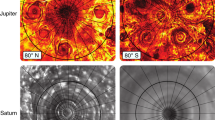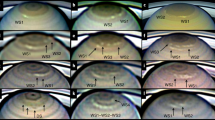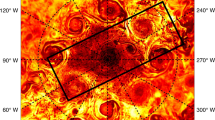Abstract
A strong cyclonic vortex has been observed on each of Saturn’s poles, coincident with a local maximum in observed tropospheric temperature1,2,3. Neptune also exhibits a relatively warm, although much more transient4, region on its south pole. Whether similar features exist on Jupiter will be resolved by the 2016 Juno mission. Energetic, small-scale storm-like features that originate from the water-cloud level or lower have been observed on each of the giant planets and attributed to moist convection, suggesting that these storms play a significant role in global heat transfer from the hot interior to space5,6. Nevertheless, the creation and maintenance of Saturn’s polar vortices, and their presence or absence on the other giant planets, are not understood. Here we use simulations with a shallow-water model to show that storm generation, driven by moist convection, can create a strong polar cyclone throughout the depth of a planet’s troposphere. We find that the type of shallow polar flow that occurs on a giant planet can be described by the size ratio of small eddies to the planetary radius and the energy density of its atmosphere due to latent heating from moist convection. We suggest that the observed difference in these parameters between Saturn and Jupiter may preclude a Jovian polar cyclone.
This is a preview of subscription content, access via your institution
Access options
Subscribe to this journal
Receive 12 print issues and online access
$259.00 per year
only $21.58 per issue
Buy this article
- Purchase on Springer Link
- Instant access to full article PDF
Prices may be subject to local taxes which are calculated during checkout




Similar content being viewed by others
Change history
06 October 2015
In the version of the Letter originally published the second sign in the energy parameter equation should have been a minus sign. This error did not affect the conclusions of the Letter and it has now been corrected in the online versions.
References
Baines, K. H. et al. Saturn’s north polar cyclone and hexagon at depth revealed by Cassini/VIMS. Planet. Space Sci. 57, 1671–1681 (2009).
Dyudina, U. A. et al. Saturn’s south polar vortex compared to other large vortices in the Solar System. Icarus 202, 240–248 (2009).
Fletcher, L. N. et al. Temperature and composition of Saturn’s polar hot spots and hexagon. Science 319, 79–81 (2008).
Luszcz-Cook, S. H., de Pater, I., Adamkovics, M. & Hammel, H. B. Seeing double at Neptune’s south pole. Icarus 208, 938–944 (2010).
Gierasch, P. J. et al. Observation of moist convection in Jupiter’s atmosphere. Nature 403, 628–630 (2000).
Ingersoll,, A. P., Gierasch,, P. J., Banfield,, D., Vasavada,, A. R. & Galileo Imaging Team. Moist convection as an energy source for the large-scale motions in Jupiter’s atmosphere. Nature 403, 630–632 (2000).
Fletcher, L. N. et al. Seasonal evolution of Saturn’s polar temperatures and composition. Icarus 250, 131–153 (2015).
Scott, R. K. Polar accumulation of cyclonic vorticity. Geophys. Astrophys. Fluid Dyn. 105, 409–420 (2011).
Adem, J. A series solution of the barotropic vorticity equation and its application in the study of atmospheric vortices. Tellus 8, 364–372 (1956).
LeBeau, R. P. Jr & Dowling, T. E. EPIC simulations of time-dependent, three-dimensional vortices with application to Neptune’s Great Dark Spot. Icarus 132, 239–265 (1998).
Scott, R. K. & Polvani, L. M. Forced-dissipative shallow-water turbulence on the sphere and the atmospheric circulation of the giant planets. J. Atmos. Sci. 64, 3158–3176 (2007).
Liu, J. & Schneider, T. Mechanisms of jet formation on the giant planets. J. Atmos. Sci. 67, 3652–3672 (2010).
O’Neill, M. E. A Theory for Polar Cyclones on Giant Planets PhD thesis, Massachusetts Institute of Technology (2015)
Showman, A. P. Numerical simulations of forced shallow-water turbulence: Effects of moist convection on the large-scale circulation of Jupiter and Saturn. J. Atmos. Sci. 64, 3132–3157 (2007).
Kaspi, Y., Flierl, G. R. & Showman, A. P. The deep wind structure of the giant planets: Results from an anelastic general circulation model. Icarus 202, 525–542 (2009).
Read, P. L., Pérez, E. P., Moroz, I. M. & Young, R. M. B. in Modeling Atmospheric and Oceanic Flows: Insights from Laboratory Experiments and Numerical Simulations (eds von Larcher, T. & Williams, P. D.) Ch. 2 (John Wiley, 2014).
Stoker, C. R. Moist convection: A mechanism for producing the vertical structure of the Jovian equatorial plumes. Icarus 67, 106–125 (1986).
Flierl, G. R. The application of linear quasigeostrophic dynamics to Gulf Stream rings. J. Phys. Oceanogr. 7, 365–379 (1977).
Read, P. L. et al. Mapping potential vorticity dynamics on Jupiter: I. Zonal mean circulation from Cassini and Voyager 1 data. Q. J. R. Meteorol. Soc. 132, 1577–1603 (2006).
Read, P. L. et al. Mapping potential vorticity dynamics on Saturn: Zonal mean circulation from Cassini and Voyager data. Planet. Space Sci. 57, 1682–1698 (2009).
Polvani, L. M., Wisdom, J., DeJong, E. & Ingersoll, A. P. Simple dynamical models of Neptune’s Great Dark Spot. Science 249, 1393–1398 (1990).
Orton, G. S. et al. Recovery and characterization of Neptune’s near-polar stratospheric hot spot. Planet. Space Sci. 61, 161–167 (2012).
Achterberg, R. K. & Ingersoll, A. P. A normal-mode approach to Jovian atmospheric dynamics. J. Atmos. Sci. 46, 2448–2462 (1989).
Pollack, J. B. et al. Formation of the giant planets by concurrent accretion of solids and gas. Icarus 124, 62–85 (1996).
Pearl, J. C. & Conrath, B. J. The albedo, effective temperature, and energy balance of Neptune, as determined from Voyager data. J. Geophys. Res. Planets 96, 18921–18930 (1991).
Porco, C. C. et al. Cassini imaging of Jupiter’s atmosphere, satellites, and rings. Science 299, 1541–1547 (2003).
Mallen, K. J., Montgomery, M. T. & Wang, B. Reexamining the near-core radial structure of the tropical cyclone primary circulation: Implications for vortex resiliency. J. Atmos. Sci. 62, 408–425 (2005).
Antuñano, A., del Río-Gaztelurrutia, T., Sánchez-Lavega, A. & Hueso, R. Dynamics of Saturn’s polar regions. J. Geophys. Res. Planets 120, 1–22 (2015).
Lian, Y. & Showman, A. P. Generation of equatorial jets by large-scale latent heating on the giant planets. Icarus 207, 373–393 (2010).
Simonnet, E., Ghil, M., Ide, K., Temam, R. & Wang, S. Low-frequency variability in shallow-water models of the wind-driven ocean circulation. Part II: time-dependent solutions. J. Phys. Oceanogr. 33, 729–752 (2003).
Vasavada, A. R. et al. Cassini imaging of Saturn: Southern hemisphere winds and vortices. J. Geophys. Res. 111, 1–13 (2006).
Conrath, B. J., Gierasch, P. J. & Leroy, S. S. Temperature and circulation in the stratosphere of the outer planets. Icarus 83, 255–281 (1990).
Acknowledgements
The authors benefited from conversations with J. Cho and A. Showman. This research was supported by the National Science Foundation Graduate Research Fellowship Program (M.E.O’N.) as well as NSF ATM-0850639, NSF AGS-1032244, NSF AGS-1136480, and ONR N00014-14-1-0062.
Author information
Authors and Affiliations
Contributions
K.A.E. proposed and oversaw the study. G.R.F. wrote the initial shallow-water code and advised adaptation by M.E.O’N. M.E.O’N. ran the simulations and interpreted the results. M.E.O’N. wrote the manuscript with editing by K.A.E. and G.R.F.
Corresponding author
Ethics declarations
Competing interests
The authors declare no competing financial interests.
Supplementary information
Supplementary Information
Supplementary Information (PDF 263 kb)
Rights and permissions
About this article
Cite this article
O’Neill, M., Emanuel, K. & Flierl, G. Polar vortex formation in giant-planet atmospheres due to moist convection. Nature Geosci 8, 523–526 (2015). https://doi.org/10.1038/ngeo2459
Received:
Accepted:
Published:
Issue Date:
DOI: https://doi.org/10.1038/ngeo2459
This article is cited by
-
Moist convection drives an upscale energy transfer at Jovian high latitudes
Nature Physics (2022)
-
Vorticity and divergence at scales down to 200 km within and around the polar cyclones of Jupiter
Nature Astronomy (2022)
-
From storms to cyclones at Jupiter’s poles
Nature Physics (2022)
-
The number and location of Jupiter’s circumpolar cyclones explained by vorticity dynamics
Nature Geoscience (2021)
-
The turbulent dynamics of Jupiter’s and Saturn’s weather layers: order out of chaos?
Geoscience Letters (2020)



